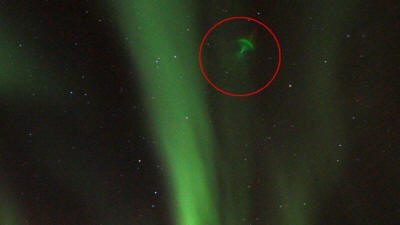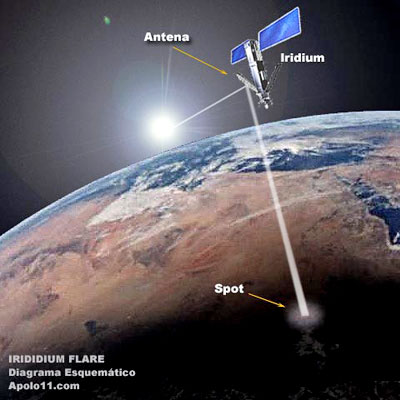|

by Ian O'Neill
January 28, 2010
from
DiscoveryNews Website

Jan. 26, 2010
This was the view
looking over the small town of Andenes, Norway, on Jan. 20.
Snaking across the
sky from horizon to horizon was a dynamic green aurora,
signaling to the
inhabitants of Earth that the sun was spraying us with an intense
stream of energetic particles.
On Jan. 20, 2010, Per-Arne Mikalsen was photographing a
vast aurora
erupting over the northern Norwegian town of Andenes.
Because solar activity is on the increase, aurora spotters have many
opportunities to see the Northern Lights. On this particular night
the aurora was intense, stretching toward the southern latitudes of
Norway.
In one of the photographs taken by Mikalsen was an "object" that
couldn't be identified. Although Mikalsen had taken several images
at the same location, just one photo showed a mysterious green
parachute-like object hanging with the main aurora. (This time, it
appears that the Russian military was not involved in the making of
this
strange shape in the sky.)
At first it seemed easy to dismiss the object as a lens flare or a
spot on the camera lens, but after further study it became clear
that the answer wasn't that simple.
Also, Mikalsen is no stranger to aurora, having worked on
Andøya
Rocket Range (on the island of Andøya) for many years.
He's seen aurora of all shapes and
sizes, but he'd never before seen a structure like this hanging in
the sky.
"I have been working the Andøya
Rocket Range for 25 years (the 20 last years in the management)
and I have become more and more fascinated by the aurora,"
Mikalsen told Discovery News. "Photography is a hobby for me."
According to Mikalsen, as soon as he
posted his aurora
photographs on the Spaceweather.com Northern
Lights Gallery, he received dozens of emails from all over the world
requesting more information about the mysterious shape.

The mystery shape in
the aurora
over Andenes, Norway, wider angle
(photograph by
Per-Arne Mikalsen)
Jan. 26, 2010 - This was
the view looking over the small town of Andenes, Norway, on Jan.
20. Snaking across the sky from horizon to horizon was a dynamic
green aurora, signaling to the inhabitants of Earth that the sun
was spraying us with an intense stream of energetic particles.
The photographer, Per-Arne Mikalsen, captured the resulting
aurora using a Canon EOS 450D camera (with a Sigma 10-20mm
1:4-5.6 DC HSM lens), but it wasn't until after he took the
photo that he realized that he'd captured something unexpected
in his lens.
After communicating with Norwegian aurora expert Truls Lynne
Hansen of the Tromsø Geophysical Observatory, compelling
evidence that the green structure hidden in the top right of the
photograph could be a reflection (or 'flare') from a satellite
flying hundreds of miles above the intense aurora.
"...the color of the 'phenomenon' is the same as the color in
the aurora, the auroral green line from atomic oxygen," Hansen
told Discovery News, "so the 'phenomenon' is either a genuine
auroral feature or a reflection of auroral light somewhere in
space."
So what could it be?
In correspondence with Truls Lynne
Hansen, lead scientist at the
Tromsø Geophysical Observatory, he
doubts that the mystery object can be explained by a technical
fault.
"Usually such aberrations appear
when there is a small and intense source of light in the field
of view, or at least so close that the light from it hits the
lens," Hansen explained to me via email. "That seems not to be
the case here."
"Additionally the color of the 'phenomenon' is the same as the
color in the aurora, the auroral green line from atomic oxygen,"
Hansen continued, "so the 'phenomenon' is either a genuine
auroral feature or a reflection of auroral light somewhere in
space."
Hold on. A reflection of auroral
light... in space? That's impossible.
Or is it?
The structured shape of the phenomenon, plus its distance from any
light sources, seems to indicate that this isn't an equipment
problem. There is also no known aurora that could do this naturally.
So that leaves the "reflection from space" argument.

How an Iridium flare
works with sunlight,
but the same should
be true for other light sources, such as aurora
(astrosat.net)
What do we have in space that could
possibly reflect the green light being emitted by the aurora?
"I agree with Pål Brekke [Senior
Advisor at the
Norwegian Space Centre] that a reflection from a
satellite is a candidate," said Hansen.
"It reminds of the
so-called 'Iridium flares' - reflections of sunlight from the
regularly shaped Iridium satellites."
Satellite flares are well known by
astronomers.
As a satellite passes overhead, the conditions may be
right for the spacecraft's solar panels or antennae to reflect
sunlight down to the ground. The result is a short-lived burst of
light, known as a "flare."
The network of
Iridium communication satellites are best known for
their flares, since they have three huge door-sized antennae that
act as orbital mirrors. Witnessing an Iridium flare is immensely
rewarding; the event can be predicted beforehand because these
satellites have orbits that can be tracked.
My personal concern about the satellite flare theory is the question
about auroral light intensity.
-
Is the light from a large aurora
bright enough to bounce off a satellite and appear as an auroral
satellite flare as a point?
-
And in turn produce a parachute-shaped,
lens flare-like projection in the photo?
I couldn't imagine even an Iridium
satellite amplifying auroral light that much (although a
stonking-huge
orbital solar power array of the future might do a better job).
"The intensity of an intense aurora
is not far from the intensity of moonlight, which is 1/100,000
of sun's light, and the solar Iridium flares apparently are
several orders of magnitude stronger than this 'auroral flare,'
so the intensity does not immediately exclude the satellite
reflection hypothesis," said Hansen.
How an Iridium flare works with
sunlight, but the same should be true for other light sources, such
as aurora (astrosat.net)
"The intensity of an intense aurora
is not far from the intensity of moonlight, which is 1/100,000
of sun's light, and the solar Iridium flares apparently are
several orders of magnitude stronger than this 'auroral flare,'
so the intensity does not immediately exclude the satellite
reflection hypothesis," said Hansen.
A weak auroral flare seems feasible, but
as pointed out by astronomer
Daniel Fischer
via Twitter, the green
flare might not have anything to do with reflected aurora light, it
could just be the color of the lens coating.
The lens flare was therefore the result
of internal reflections inside the camera lens caused by the bright
lights in the lower left-hand corner of the frame.
"It has the typical caustic shape
and it is opposite several bright point lights," Fischer
observed. "Green color could be caused by lens coatings."
Although more research will need to be
done, it certainly seems plausible that Per-Arne Mikalsen
serendipitously took a photograph of a satellite flare (possibly an
Iridium satellite).
What makes this revelation even more exciting is that we've never
seen an auroral reflection from a satellite before (if it's not a
lens flare, that is).
"I have, by the way, never seen or
heard of a similar phenomenon," Hansen said.
Videos
|



